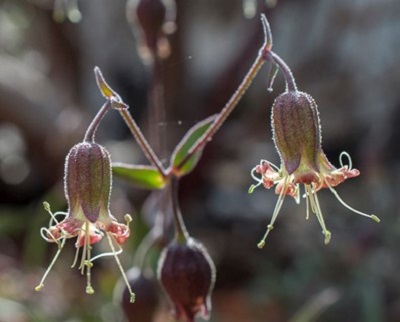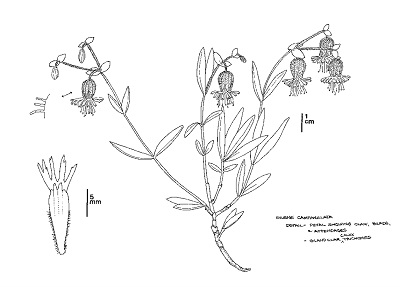(Silene campanulata ssp. campanulata)
 Silene campanulata ssp. campanulata. CDFW photo by Jeb Bjerke.
Silene campanulata ssp. campanulata. CDFW photo by Jeb Bjerke.
 Silene campanulata. CDFW illustration by Mary Ann Showers. (Click to enlarge)
Silene campanulata. CDFW illustration by Mary Ann Showers. (Click to enlarge)
Red Mountain catchfly is a California endangered plant species, which means that killing or possessing any part of the plant is prohibited by the California Endangered Species Act (CESA). It is only known to occur on Red Mountain and Little Red Mountain in Mendocino county in northwestern California. There are seven occurrences of Red Mountain catchfly documented in the California Natural Diversity Database, however, the identification of one occurrence observed in Colusa county in 1989 needs confirmation. Red Mountain catchfly is a perennial herb in the pink family (Caryophyllaceae). It grows between 2-8 inches tall with stems that have short glandular hairs and long narrow leaves. It blooms from April to July and has cream to greenish or pink flowers that have fringed tips with multiple lobes.
This species is found in lower montane coniferous forests and chaparral communities on dry, rocky, serpentine and ultramafic soils between 3,000 and 4,500 feet in elevation. Plant species associated with Red Mountain catchfly include hoary manzanita (Arctostaphylos canescens), boxleaf silk tassel (Garrya buxifolia), huckleberry oak (Quercus vacciniifolia), Siskiyou mat (Ceanothus pumilus), and the state- and federally-listed endangered McDonald’s rock cress (Arabis mcdonaldiana) and Kellogg’s buckwheat (Eriogonum kelloggii).
There have been between 250-300 individual plants reported at the two largest occurrences and fewer than 100 individual plants at the remaining four occurrences. The populations occur on private land, mining company land, Bureau of Land Management land, United States Fish and Wildlife Service lands, and on the California Department of Fish and Wildlife’s Little Red Mountain Ecological Reserve. The major threats to the Red Mountain catchfly occur on privately owned and BLM land which are subject to logging activity, and surface and subsurface mining operations for nickel and cobalt.
The validity of this species has been called into question because of populations discovered in the Shasta-Trinity National Forest that have intermediate traits between the Red Mountain catchfly and the bell catchfly (Silene campanulata subsp. glandulosa). These populations grow on non-serpentine granitic soils but resemble Red Mountain catchfly with glandular hairs on the stems and a leaf width that falls between the Red mountain and the bell catchfly. Studies have suggested that these populations represent a single species with the differences in traits a result of its geographic distribution. This would mean that the Red Mountain catchfly is either more widespread than once thought or, that these intermediate populations are the beginning of a speciation event driven by different habitat conditions. Further study of these intermediate plant populations is needed.
Recovery efforts for the Red Mountain catchfly will rely on long-term monitoring and scientific research on the genetic and morphological variability of the species. As a part of a monitoring plan for Kellogg’s buckwheat (PDF), the California Department of Fish and Wildlife observed and recorded additional populations of Red Mountain catchfly at Little Red Mountain Ecological Reserve.
CDFW may issue scientific and research permits for Red mountain catchfly pursuant to CESA, and you can visit our website to learn more about the California laws protecting Red mountain catchfly and other California native plants. Populations of Red mountain catchfly occur in CDFW’s Northern Region and the North Central Region.
Updated 8/14/2020